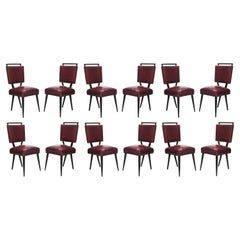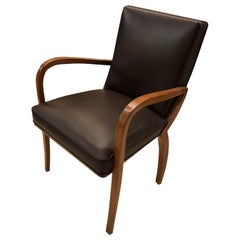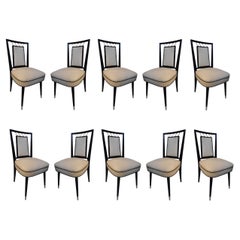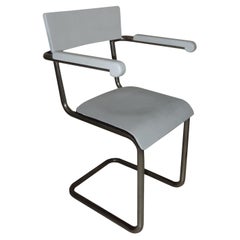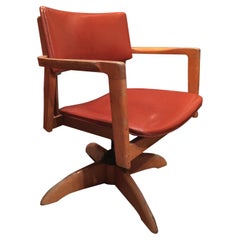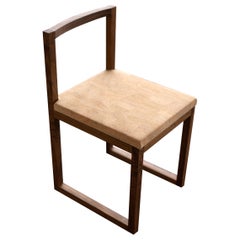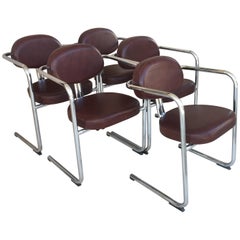Argentina - Office Chairs and Desk Chairs
to
1,156
1,145
16
Height
to
Width
to
Depth
to
11
3
1
1
1
1
1
8
4
16
3
12
1
3
5
3
3
1
1
12
9
9
6
4
12
5
3
3
3
16
16
16
Item Ships From: Argentina
Set of 12 Chairs 50° in Leather and Wood, Italian
Located in Ciudad Autónoma Buenos Aires, C
12 Chairs
Style: 50°
Italian
Materials: wood, leather and chrome bronze
Finish: polyurethanic lacquer
We have specialized in the sale of Art Deco and Art Nouveau and Vintage s...
Category
1950s Italian Mid-Century Modern Vintage Argentina - Office Chairs and Desk Chairs
Materials
Leather, Wood
$40,000 / set
Desk Chair Style: Art Deco, France, Material Wood and Leather, 1930
Located in Ciudad Autónoma Buenos Aires, C
Art Deco desk chair
Material: leather and wood
Year: 1930
Country: France
If you are looking for a desk chair to match your desk, we have what you nee...
Category
1930s French Art Deco Vintage Argentina - Office Chairs and Desk Chairs
Materials
Leather, Wood
Pair of Armchairs in Leather and iron, 1935
Located in Ciudad Autónoma Buenos Aires, C
Art Deco armchairs in Leather and iron attributed to Jean Michel Frank
Year 1935
Elegant and sophisticated armchairs.
You want to live in the golden years, these are the armchairs y...
Category
1930s Argentine Art Deco Vintage Argentina - Office Chairs and Desk Chairs
Materials
Iron
$220,000 / set
Set of 10 Chairs 60° in Leather, Bronze and Wood, Italian
Located in Ciudad Autónoma Buenos Aires, C
Wooden table with chromed bronze ferrules
Style: 60°
Italian
Materials: wood, leather and chrome bronze
Finish: polyurethanic lacquer
We have specialized in the sale of Art Deco and ...
Category
1960s Italian Mid-Century Modern Vintage Argentina - Office Chairs and Desk Chairs
Materials
Chrome
Armchair in Wood and Chrome, Style: Bauhaus, German, 1940
Located in Ciudad Autónoma Buenos Aires, C
Armchair
Wood and chrome
Year: 1940
Country: Germany
We have specialized in the sale of Art Deco and Art Nouveau and Vintage styles since 1982. If you have any questions we are at ...
Category
1940s German Bauhaus Vintage Argentina - Office Chairs and Desk Chairs
Materials
Chrome
American Desk Armchair, 1950
Located in Ciudad Autónoma Buenos Aires, C
Art Deco desk chair
Wood
Year: 1950
If you are looking for a desk chair to match your desk, we have what you need.
We have specialized in the sale of Art Deco and Art Nouveau and Vintage styles since 1982.
Pushing the button that reads 'View All From Seller'. And you can see more objects to the style for sale.
Why are there so many antiques in Argentina?
In the 1880 – 1940 there was a grate wave of immigration encouraged by the periods of war that were taking place.
1st World War took place between 1914 and 1918
2nd World War took place between 1939 and 1945
The immigrants options were New York or Buenos Aires. Tickets were cheap and in Buenos Aires they were welcomed with open arms, as it was a country where everything was still to be done.
Argentina was the country of new opportunities, labour was needed and religious freedom was assured, in many cases the of the family travel first until they were settled and then the rest of the family members join them.
In the immigrant museum “Ellis Island Immigrant Building” in New York you can se the promotional posters of the boats that would take them to a new life.
Between the years 1895 and 1896, Argentina had the highest DGP (gross domestic product) per capita in the world according to the Maddison Historical Statistics index, this situation arose due to the large amount of food being exported to European countries, which were at war.
The Argentinean ships left the port of Buenos Aires with food, but they returned with furniture, clothes and construction elements, (it´s common to see this the old buildings of the historic neighbourhood of San Telmo, the beams with the inscription “Made in England)”, as well as many markets that were built in Buenos Aires, such us the San Telmo Market, whose structure was brought by ship and afterwards assembled in 900 Defensa Street.
With the great influence of European immigrants living in the country, the children of the upper classes travelled to study in France, resulting in the inauguration of “La Maison Argentinienne”, on 27th of June 1928, in the international city of Paris, which hosted many Argentinians that were studying in Frace.
It´s the fourth house to be built after France, Canada and Belgium, being the first Spanish-speaking one. Still in place today (17 Bd Jourdan, 75014, Paris, France). Many of the children of these wealthy families who attended international art exhibitions, museums and art courses abroad, took a keen interest in the European style. This is why Buenos Aires was at the time referred as “The Paris of South America”.
Between the years 1890 and 1920 more than a hundred Palaces were built on Alvear Avenue the most exclusive avenue in Buenos Aires. Today some of these palaces have been transformed into museums, hotels and embassies.
In the year 1936, the Kavanagh building was inaugurated, it was the tallest reinforced concrete building in South America.
During 1994 the American Society of Civil Engineers distinguished it as an “international engineering milestone”, and it´s now considered a World Heritage of Modern Architecture.
At the time was common to hire foreign architects such as Le Corbusier, who visited Buenos Aires/Argentina in 1929 and in 1948 he drew up the blueprints for a house built in La Plata City (which was declared a World Heritage Site).
In 1947, the Hungarian architect Marcelo Breuer designed “Parador Ariston” in the seaside city of Mar del Plata. After an Argentinean student at Harvard University convinced him to come to Argentina. He worked on an urban development project in the Casa Amarilla, area of La Boca.
The Ukrainian architect, Vladimiro Acosta, arrives in Argentina in 1928 and worked as an architect until que moved to Brazil.
Antonio Bonet, a Spanish architect who worked with Le Corbusier in Paris, arrives in Argentina in 1937, where he carried out several architectural works and in 1938 designs the well-known BFK chair...
Category
1950s American Mid-Century Modern Vintage Argentina - Office Chairs and Desk Chairs
Materials
Wood
Set of 8 Chairs 50° in Leather and Wood, Danish
Located in Ciudad Autónoma Buenos Aires, C
We have specialized in the sale of Art Deco and Art Nouveau and Vintage styles since 1982. If you have any questions we are at your disposal.
Pushing the button that reads 'View All ...
Category
1950s Danish Mid-Century Modern Vintage Argentina - Office Chairs and Desk Chairs
Materials
Leather, Wood
$48,000 / set
Pair of Solid Lucite Vanity Chair, 1940s
Located in Ciudad Autónoma Buenos Aires, C
Pair of solid lucite chairs
We have specialized in the sale of Art Deco and Art Nouveau and Vintage styles since 1982. If you have any questions we are at your disposal.
Pushing the button that reads 'View All From Seller'. And you can see more objects to the style for sale.
Why are there so many antiques in Argentina?
In the 1880 – 1940 there was a grate wave of immigration encouraged by the periods of war that were taking place.
1st World War took place between 1914 and 1918
2nd World War took place between 1939 and 1945
The immigrants options were New York or Buenos Aires. Tickets were cheap and in Buenos Aires they were welcomed with open arms, as it was a country where everything was still to be done.
Argentina was the country of new opportunities, labour was needed and religious freedom was assured, in many cases the of the family travel first until they were settled and then the rest of the family members join them.
In the immigrant museum “Ellis Island Immigrant Building” in New York you can se the promotional posters of the boats that would take them to a new life.
Between the years 1895 and 1896, Argentina had the highest DGP (gross domestic product) per capita in the world according to the Maddison Historical Statistics index, this situation arose due to the large amount of food being exported to European countries, which were at war.
The Argentinean ships left the port of Buenos Aires with food, but they returned with furniture, clothes and construction elements, (it´s common to see this the old buildings of the historic neighbourhood of San Telmo, the beams with the inscription “Made in England)”, as well as many markets that were built in Buenos Aires, such us the San Telmo Market, whose structure was brought by ship and afterwards assembled in 900 Defensa Street.
With the great influence of European immigrants living in the country, the children of the upper classes travelled to study in France, resulting in the inauguration of “La Maison Argentinienne”, on 27th of June 1928, in the international city of Paris, which hosted many Argentinians that were studying in Frace.
It´s the fourth house to be built after France, Canada and Belgium, being the first Spanish-speaking one. Still in place today (17 Bd Jourdan, 75014, Paris, France). Many of the children of these wealthy families who attended international art exhibitions, museums and art courses abroad, took a keen interest in the European style. This is why Buenos Aires was at the time referred as “The Paris of South America”.
Between the years 1890 and 1920 more than a hundred Palaces were built on Alvear Avenue the most exclusive avenue in Buenos Aires. Today some of these palaces have been transformed into museums, hotels and embassies.
In the year 1936, the Kavanagh building was inaugurated, it was the tallest reinforced concrete building in South America.
During 1994 the American Society of Civil Engineers distinguished it as an “international engineering milestone”, and it´s now considered a World Heritage of Modern Architecture.
At the time was common to hire foreign architects such as Le Corbusier, who visited Buenos Aires/Argentina in 1929 and in 1948 he drew up the blueprints for a house built in La Plata City (which was declared a World Heritage Site).
In 1947, the Hungarian architect Marcelo Breuer designed “Parador Ariston” in the seaside city of Mar del Plata. After an Argentinean student at Harvard University convinced him to come to Argentina. He worked on an urban development project in the Casa Amarilla, area of La Boca.
The Ukrainian architect, Vladimiro Acosta, arrives in Argentina in 1928 and worked as an architect until que moved to Brazil.
Antonio Bonet, a Spanish architect who worked with Le Corbusier in Paris, arrives in Argentina in 1937, where he carried out several architectural works and in 1938 designs the well-known BFK chair...
Category
1940s American Space Age Vintage Argentina - Office Chairs and Desk Chairs
Materials
Lucite
$12,000 / set
Armchair in Wood and Chrome, Style: Bauhaus, German, 1940
Located in Ciudad Autónoma Buenos Aires, C
Armchair
Wood and chrome
Year: 1940
Country: Germany
If you are looking for a desk chair to match your desk, we have what you need.
We have specialized in the sale of Art Deco and...
Category
1940s German Bauhaus Vintage Argentina - Office Chairs and Desk Chairs
Materials
Chrome
Desk Chair Style: Art Deco, France, 1930
Located in Ciudad Autónoma Buenos Aires, C
Art Deco desk chair
Wood
Year: 1930
Country: France
If you are looking for a desk chair to match your desk, we have what you need.
We have specialized in the sale of Art Deco and Art Nouveau and Vintage styles since 1982.
Pushing the button that reads 'View All From Seller'. And you can see more objects to the style for sale.
Why are there so many antiques in Argentina?
In the 1880 – 1940 there was a grate wave of immigration encouraged by the periods of war that were taking place.
1st World War took place between 1914 and 1918
2nd World War took place between 1939 and 1945
The immigrants options were New York or Buenos Aires. Tickets were cheap and in Buenos Aires they were welcomed with open arms, as it was a country where everything was still to be done.
Argentina was the country of new opportunities, labour was needed and religious freedom was assured, in many cases the of the family travel first until they were settled and then the rest of the family members join them.
In the immigrant museum “Ellis Island Immigrant Building” in New York you can se the promotional posters of the boats that would take them to a new life.
Between the years 1895 and 1896, Argentina had the highest DGP (gross domestic product) per capita in the world according to the Maddison Historical Statistics index, this situation arose due to the large amount of food being exported to European countries, which were at war.
The Argentinean ships left the port of Buenos Aires with food, but they returned with furniture, clothes and construction elements, (it´s common to see this the old buildings of the historic neighbourhood of San Telmo, the beams with the inscription “Made in England)”, as well as many markets that were built in Buenos Aires, such us the San Telmo Market, whose structure was brought by ship and afterwards assembled in 900 Defensa Street.
With the great influence of European immigrants living in the country, the children of the upper classes travelled to study in France, resulting in the inauguration of “La Maison Argentinienne”, on 27th of June 1928, in the international city of Paris, which hosted many Argentinians that were studying in Frace.
It´s the fourth house to be built after France, Canada and Belgium, being the first Spanish-speaking one. Still in place today (17 Bd Jourdan, 75014, Paris, France). Many of the children of these wealthy families who attended international art exhibitions, museums and art courses abroad, took a keen interest in the European style. This is why Buenos Aires was at the time referred as “The Paris of South America”.
Between the years 1890 and 1920 more than a hundred Palaces were built on Alvear Avenue the most exclusive avenue in Buenos Aires. Today some of these palaces have been transformed into museums, hotels and embassies.
In the year 1936, the Kavanagh building was inaugurated, it was the tallest reinforced concrete building in South America.
During 1994 the American Society of Civil Engineers distinguished it as an “international engineering milestone”, and it´s now considered a World Heritage of Modern Architecture.
At the time was common to hire foreign architects such as Le Corbusier, who visited Buenos Aires/Argentina in 1929 and in 1948 he drew up the blueprints for a house built in La Plata City (which was declared a World Heritage Site).
In 1947, the Hungarian architect Marcelo Breuer designed “Parador Ariston” in the seaside city of Mar del Plata. After an Argentinean student at Harvard University convinced him to come to Argentina. He worked on an urban development project in the Casa Amarilla, area of La Boca.
The Ukrainian architect, Vladimiro Acosta, arrives in Argentina in 1928 and worked as an architect until que moved to Brazil.
Antonio Bonet, a Spanish architect who worked with Le Corbusier in Paris, arrives in Argentina in 1937, where he carried out several architectural works and in 1938 designs the well-known BFK chair...
Category
1930s French Art Deco Vintage Argentina - Office Chairs and Desk Chairs
Materials
Wood
American Desk Armchair, 1970
Located in Ciudad Autónoma Buenos Aires, C
Armchair
Year: 1970
We have specialized in the sale of Art Deco and Art Nouveau and Vintage styles since 1982. If you have any questions we are at your disposal.
Pushing the button t...
Category
1970s American Art Deco Vintage Argentina - Office Chairs and Desk Chairs
Materials
Chrome
Desk Chair Style: Art Deco, France, 1920
Located in Ciudad Autónoma Buenos Aires, C
Art Deco desk chair
Country: France
If you are looking for a desk chair to match your desk, we have what you need.
We have specialized in the sale of Art Deco and Art Nouveau and Vintage styles since 1982. If you have any questions we are at your disposal.
Pushing the button that reads 'View All From Seller'. And you can see more objects to the style for sale.
Why are there so many antiques in Argentina?
In the 1880 – 1940 there was a grate wave of immigration encouraged by the periods of war that were taking place.
1st World War took place between 1914 and 1918
2nd World War took place between 1939 and 1945
The immigrants options were New York or Buenos Aires. Tickets were cheap and in Buenos Aires they were welcomed with open arms, as it was a country where everything was still to be done.
Argentina was the country of new opportunities, labour was needed and religious freedom was assured, in many cases the of the family travel first until they were settled and then the rest of the family members join them.
In the immigrant museum “Ellis Island Immigrant Building” in New York you can se the promotional posters of the boats that would take them to a new life.
Between the years 1895 and 1896, Argentina had the highest DGP (gross domestic product) per capita in the world according to the Maddison Historical Statistics index, this situation arose due to the large amount of food being exported to European countries, which were at war.
The Argentinean ships left the port of Buenos Aires with food, but they returned with furniture, clothes and construction elements, (it´s common to see this the old buildings of the historic neighbourhood of San Telmo, the beams with the inscription “Made in England)”, as well as many markets that were built in Buenos Aires, such us the San Telmo Market, whose structure was brought by ship and afterwards assembled in 900 Defensa Street.
With the great influence of European immigrants living in the country, the children of the upper classes travelled to study in France, resulting in the inauguration of “La Maison Argentinienne”, on 27th of June 1928, in the international city of Paris, which hosted many Argentinians that were studying in Frace.
It´s the fourth house to be built after France, Canada and Belgium, being the first Spanish-speaking one. Still in place today (17 Bd Jourdan, 75014, Paris, France). Many of the children of these wealthy families who attended international art exhibitions, museums and art courses abroad, took a keen interest in the European style. This is why Buenos Aires was at the time referred as “The Paris of South America”.
Between the years 1890 and 1920 more than a hundred Palaces were built on Alvear Avenue the most exclusive avenue in Buenos Aires. Today some of these palaces have been transformed into museums, hotels and embassies.
In the year 1936, the Kavanagh building was inaugurated, it was the tallest reinforced concrete building in South America.
During 1994 the American Society of Civil Engineers distinguished it as an “international engineering milestone”, and it´s now considered a World Heritage of Modern Architecture.
At the time was common to hire foreign architects such as Le Corbusier, who visited Buenos Aires/Argentina in 1929 and in 1948 he drew up the blueprints for a house built in La Plata City (which was declared a World Heritage Site).
In 1947, the Hungarian architect Marcelo Breuer designed “Parador Ariston” in the seaside city of Mar del Plata. After an Argentinean student at Harvard University convinced him to come to Argentina. He worked on an urban development project in the Casa Amarilla, area of La Boca.
The Ukrainian architect, Vladimiro Acosta, arrives in Argentina in 1928 and worked as an architect until que moved to Brazil.
Antonio Bonet, a Spanish architect who worked with Le Corbusier in Paris, arrives in Argentina in 1937, where he carried out several architectural works and in 1938 designs the well-known BFK...
Category
1920s French Art Deco Vintage Argentina - Office Chairs and Desk Chairs
Materials
Wood
Desk Chair in Leather and Wood, Style: Art Deco, France, 1930
Located in Ciudad Autónoma Buenos Aires, C
Art Deco Armchair
Wood and leather
Year: 1930
Country: France
If you are looking for a desk chair to match your desk, we have what you need.
We have specialized in the sale of Art ...
Category
1930s French Art Deco Vintage Argentina - Office Chairs and Desk Chairs
Materials
Wood, Leather
Desk Chair for the King, Style: Art Deco, 1930, German
Located in Ciudad Autónoma Buenos Aires, C
Art Deco desk chair
Material: leather and wood
Year: 1930
Country: Germany
If you are looking for a desk chair to match your desk, we have what you ne...
Category
1930s German Art Deco Vintage Argentina - Office Chairs and Desk Chairs
Materials
Leather, Wood
Armchair Art Deco, France, 1920, Materials, Leather and Golden Iron
Located in Ciudad Autónoma Buenos Aires, C
Armchairs Art Deco
Year 1920
Materials :Leather and golden iron
Country: French
Elegant and sophisticated armchairs.
You want to live in the golden years, these are the armchairs yo...
Category
1920s French Art Deco Vintage Argentina - Office Chairs and Desk Chairs
Materials
Iron, Gold Leaf
4 Chair, Italian, 1950
Located in Ciudad Autónoma Buenos Aires, C
4 Chairs
Country: Italian
If you are looking for a desk chair to match your desk, we have what you need.
We have specialized in the sale of Art Deco and Art Nouveau and Vintage styles since 1982.If you have any questions we are at your disposal.
Pushing the button that reads 'View All From Seller'. And you can see more objects to the style.
Why are there so many antiques in Argentina?
In the 1880 – 1940 there was a grate wave of immigration encouraged by the periods of war that were taking place.
1st World War took place between 1914 and 1918
2nd World War took place between 1939 and 1945
The immigrants options were New York or Buenos Aires. Tickets were cheap and in Buenos Aires they were welcomed with open arms, as it was a country where everything was still to be done.
Argentina was the country of new opportunities, labour was needed and religious freedom was assured, in many cases the of the family travel first until they were settled and then the rest of the family members join them.
In the immigrant museum “Ellis Island Immigrant Building” in New York you can se the promotional posters of the boats that would take them to a new life.
Between the years 1895 and 1896, Argentina had the highest DGP (gross domestic product) per capita in the world according to the Maddison Historical Statistics index, this situation arose due to the large amount of food being exported to European countries, which were at war.
The Argentinean ships left the port of Buenos Aires with food, but they returned with furniture, clothes and construction elements, (it´s common to see this the old buildings of the historic neighbourhood of San Telmo, the beams with the inscription “Made in England)”, as well as many markets that were built in Buenos Aires, such us the San Telmo Market, whose structure was brought by ship and afterwards assembled in 900 Defensa Street.
With the great influence of European immigrants living in the country, the children of the upper classes travelled to study in France, resulting in the inauguration of “La Maison Argentinienne”, on 27th of June 1928, in the international city of Paris, which hosted many Argentinians that were studying in Frace.
It´s the fourth house to be built after France, Canada and Belgium, being the first Spanish-speaking one. Still in place today (17 Bd Jourdan, 75014, Paris, France). Many of the children of these wealthy families who attended international art exhibitions, museums and art courses abroad, took a keen interest in the European style. This is why Buenos Aires was at the time referred as “The Paris of South America”.
Between the years 1890 and 1920 more than a hundred Palaces were built on Alvear Avenue the most exclusive avenue in Buenos Aires. Today some of these palaces have been transformed into museums, hotels and embassies.
In the year 1936, the Kavanagh building was inaugurated, it was the tallest reinforced concrete building in South America.
During 1994 the American Society of Civil Engineers distinguished it as an “international engineering milestone”, and it´s now considered a World Heritage of Modern Architecture.
At the time was common to hire foreign architects such as Le Corbusier, who visited Buenos Aires/Argentina in 1929 and in 1948 he drew up the blueprints for a house built in La Plata City (which was declared a World Heritage Site).
In 1947, the Hungarian architect Marcelo Breuer designed “Parador Ariston” in the seaside city of Mar del Plata. After an Argentinean student at Harvard University convinced him to come to Argentina. He worked on an urban development project in the Casa Amarilla, area of La Boca.
The Ukrainian architect, Vladimiro Acosta, arrives in Argentina in 1928 and worked as an architect until que moved to Brazil.
Antonio Bonet, a Spanish architect who worked with Le Corbusier in Paris, arrives in Argentina in 1937, where he carried out several architectural works and in 1938 designs the well-known BFK chair...
Category
1920s Italian Space Age Vintage Argentina - Office Chairs and Desk Chairs
Materials
Wood
$4,000 / item
Related Items
Walnut Wood and Cork Chair, Dining or Writing Desk Chair, Porto Chair
By Alabama Sawyer
Located in Birmingham, AL
The Porto chair embraces the fusion of timeless elegance and functional minimalism. This streamlined chair complements your urban wood dining table or writing desk. With its versatil...
Category
2010s American American Craftsman Argentina - Office Chairs and Desk Chairs
Materials
Wood
$1,450 / item
H 30 in W 16 in D 18 in
Vintage Italian Brown Leather and Chrome Armchairs, 1980s, Set of Five
Located in Miami, FL
Vintage Italian brown leather and chrome armchairs, 1980s, set of five.
Category
Mid-20th Century Italian Mid-Century Modern Argentina - Office Chairs and Desk Chairs
Materials
Chrome
Pair of Kaare Klint Armchairs
By Kaare Klint
Located in Los Angeles, CA
Pair of Kaare Klint armchairs designed in 1927 and produced by Rud Rasmussen. Store formerly known as ARTFUL DODGER INC
Category
1940s Danish Scandinavian Modern Vintage Argentina - Office Chairs and Desk Chairs
Materials
Fabric, Mahogany
Giorgio Collection Ebony Macassar Wood and Leather Office Desk Chair
By Giorgio Collection
Located in New York, NY
Giorgio Collection ebony Macassar wood and leather Art Deco Presidential Office chair. Residential office chair on wheels with adjust...
Category
21st Century and Contemporary Italian Art Deco Argentina - Office Chairs and Desk Chairs
Materials
Leather, Ebony
French Cane Back Louis XVI, Directoire Style Desk Armchair
Located in Montreal, Quebec
French Cane Back Louis XVI - Directoire style desk armchair.
Category
20th Century Unknown Louis XVI Argentina - Office Chairs and Desk Chairs
Materials
Cane, Wood
Italian Alberto Meda Office Chair for Vitra in Red Leather 1990
By Alberto Meda, Vitra
Located in Byron Bay, NSW
Red Leather and aluminium adjstable office chair by Alberto Meda for Vitra 1990
Perfect working condition.
Category
20th Century Italian Modern Argentina - Office Chairs and Desk Chairs
Materials
Aluminum
$2,200
H 38.98 in W 27.56 in D 21.66 in
Fine French 1940s Mahogany Armchairs by Jules Leleu
By Jules Leleu
Located in Long Island City, NY
Jules Leleu (1883-1961) - A fine French Art Deco mahogany arm chairs.
Category
1940s French Art Deco Vintage Argentina - Office Chairs and Desk Chairs
Materials
Fabric, Mahogany
Walnut Wood and Cork Barstool, Porto Chair Style Bar Seating Set of Four (4)
By Alabama Sawyer
Located in Birmingham, AL
A modern and environmentally-friendly bar seating solution, the Porto Barstool offers versatility and sophistication to complement your interior design style. Cork trees are relative...
Category
2010s American American Craftsman Argentina - Office Chairs and Desk Chairs
Materials
Wood, Walnut, Cork
$7,000
H 42 in W 16 in D 18 in
Pair of French Art Deco Armchairs
Located in Long Island City, NY
A pair of French 1930s beech bridge / office chairs.
Category
1930s French Art Deco Vintage Argentina - Office Chairs and Desk Chairs
Materials
Beech
Vintage Germany Icon Bauhaus B35 Black Leather Chair by Marcel Breuer for Thonet
By Thonet, Marcel Breuer
Located in Warszawa, Mazowieckie
This design icon from 1928, the B35 armchair, was designed by Marcel Breuer in the late 1920s and made by the German Thonet factory in the early 1930s. This piece is made of tubular steel and black leather with natural patina. The materials used and the traces of wear show that this is an early production of this timeless modell. The armrests are finished with solid wood. Following the success of his Wassily chair, Breuer continued to experiment with tubular steel furniture. Like the Wassily chair, the B35 was not a direct representative of the Bauhaus school, but is clearly in line with the Bauhaus design and construction principles, with a modern, stripped-down form made of industrial materials not used today in furniture production.
Marcel Breuer was born in 1902 in Hungary. He was an architect and designer. He received a scholarship to study painting and sculpture at the Vienna Academy of Fine Arts in 1920, but quickly quit and applied to the Bauhaus school in Weimar, Germany. After completing the preliminary courses there, he studied at the Bauhaus furniture...
Category
1930s German Bauhaus Vintage Argentina - Office Chairs and Desk Chairs
Materials
Chrome
$6,420 Sale Price
20% Off
H 34.26 in W 24.41 in D 30.32 in
Completely Restored Dan Johnson for Viscount Mid-Century Brass Armchair 1950s
By Dan Johnson, Kodawood
Located in St. Louis, MO
Dan Johnson "Viscount" for Kodawood, distributed by Selig, armchair or desk chair, circa 1950s. Refinished in dark ebony stain with new foam, orange leather and polished brass. Arm h...
Category
Mid-20th Century American Mid-Century Modern Argentina - Office Chairs and Desk Chairs
Materials
Brass
$2,650
H 27.75 in W 22.25 in D 20.75 in
Mid-Century Danish Modern Rosewood Desk Office Side Chair Armchair
Located in Wayne, NJ
Mid-Century Danish modern rosewood desk office side armchair. If you are in the New Jersey , New York City Metro Area , please contact us with your delivery zip code, as we may be ab...
Category
1970s Mid-Century Modern Vintage Argentina - Office Chairs and Desk Chairs
Materials
Other
$840 Sale Price
30% Off
H 34.25 in W 25.75 in D 22 in
Read More
Ask an Interior Designer: Work-from-Home Edition
Leaping into a design project, whether it's refreshing the bedroom or redoing the whole house, can be overwhelming. Luckily, we know more than a few interior designers. You asked questions on Instagram, and now they're answering.
18 Home Offices for Workaholic Design-Lovers
Proof that working from home is a perk.
Recently Viewed
View AllMore Ways To Browse
Ds 35 Chair
Harvey Probber Desk Chairs
Hickory Chair Desk
Ico Parisi Office Chair For Mim Roma
Jasper Morrison Desk
Otto Zapf Desk Chair
Purple North American Office Chairs and Desk Chairs
Ralph Lauren Desk Chair
Restoration Hardware Swivel Chair
Sapper Executive
Spanish Animal Skin Office Chairs and Desk Chairs
Supporto Chair
Vitra Eames Soft Pad
Eames Ea117
Eames Ea216
Emeco Chair Swivel
Knoll X Supreme
Martin Stoll Giroflex
